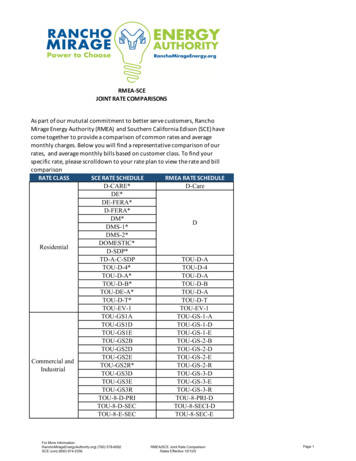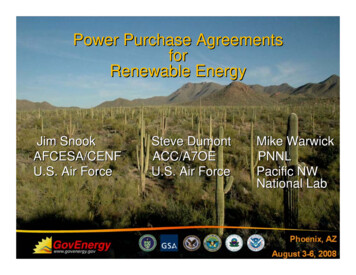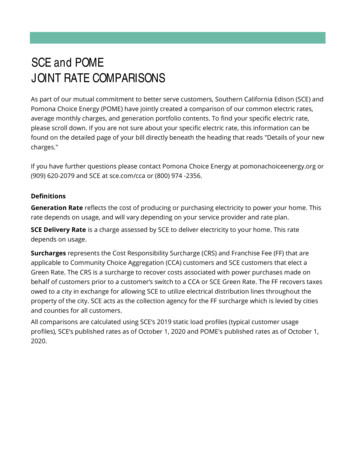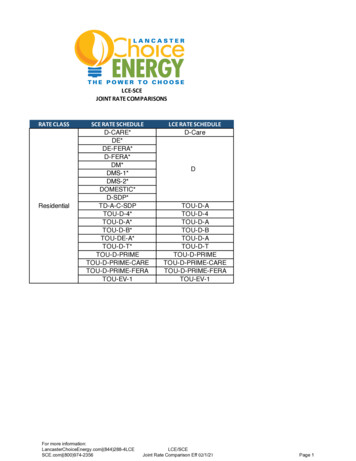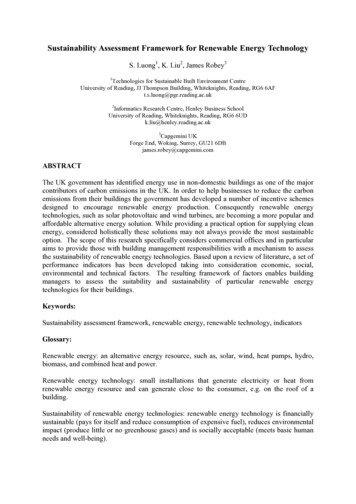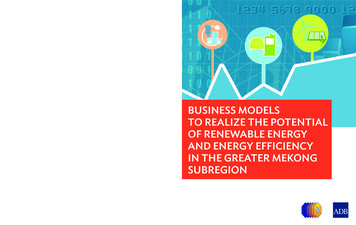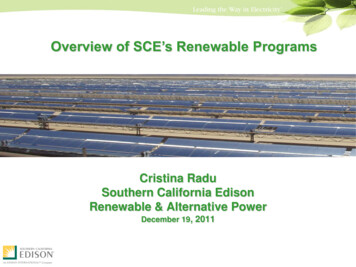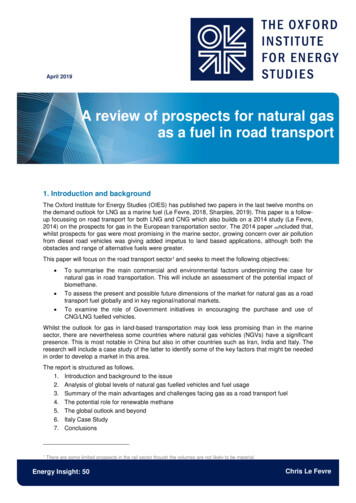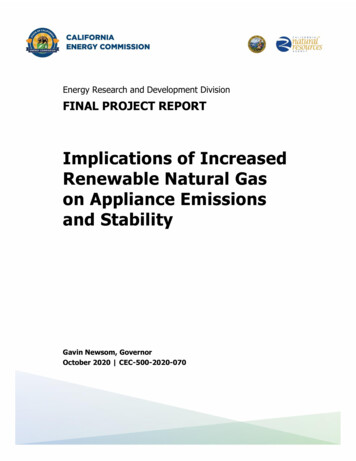
Transcription
Energy Research and Development DivisionFINAL PROJECT REPORTImplications of IncreasedRenewable Natural Gason Appliance Emissionsand StabilityGavin Newsom, GovernorOctober 2020 CEC-500-2020-070
PREPARED BY:Primary Author:Vincent McDonellYan ZhaoShiny ChoudhuryUCI Combustion LaboratoryUniversity of California, Irvine949 824 5950 x11121www.ucicl.uci.eduContract Number: PIR-16-017PREPARED FOR:California Energy CommissionEstella ShiProject ManagerVirginia LewOffice ManagerENERGY EFFICIENCY RESEARCH OFFICELaurie ten HopeDeputy DirectorENERGY RESEARCH AND DEVELOPMENT DIVISIONDrew BohanExecutive DirectorDISCLAIMERThis report was prepared as the result of work sponsored by the California Energy Commission. It does not necessarilyrepresent the views of the Energy Commission, its employees or the State of California. The Energy Commission, theState of California, its employees, contractors and subcontractors make no warranty, express or implied, and assumeno legal liability for the information in this report; nor does any party represent that the uses of this information willnot infringe upon privately owned rights. This report has not been approved or disapproved by the California EnergyCommission nor has the California Energy Commission passed upon the accuracy or adequacy of the information inthis report.
ACKNOWLEDGEMENTSThe authors acknowledge David Morales, Leslie Hsiao and Max Venaas for their help on thisproject. Suggestions and technical support from technical advisory committee members arealso appreciated.Technical Advisory Committee members: Amin Akbari (Raypak), amin.akbari@raypak.com Marc Carreras (South Coast Air Quality Management District), msospedra@aqmd.gov Jeff Chase (Southern California Gas Company), jchase@socalgas.com Matt Gregori (Southern California Gas Company), mgregori@socalgas.com May Lew (Southern California Gas Company), mlew@semprautilities.com Rosalva Lopez (California Air Resources Board), rlopez@arb.ca.gov Dave Mehl (California Air Resources Board), dmehl@arb.ca.gov Steve Simons (Southern California Gas Company-Retired), ssimons@semprautilities.com Dana Waters (California Air Resources Board), dana.waters@arb.ca.govi
PREFACEThe California Energy Commission’s (CEC) Energy Research and Development Divisionmanages the Natural Gas Research and Development Program, which supports energy-relatedresearch, development, and demonstration not adequately provided by competitive andregulated markets. These natural gas research investments spur innovation in energyefficiency, renewable energy and advanced clean generation, energy-related environmentalprotection, energy transmission and distribution and transportation.The Energy Research and Development Division conducts this public interest natural gasrelated energy research by partnering with research, development, and demonstration entities,including individuals, businesses, utilities and public and private research institutions. Thisprogram promotes greater natural gas reliability, lower costs and increases safety forCalifornians and is focused in these areas: Buildings End-Use Energy Efficiency. Industrial, Agriculture and Water Efficiency. Renewable Energy and Advanced Generation. Natural Gas Infrastructure Safety and Integrity. Energy-Related Environmental Research. Natural Gas-Related Transportation.Implications of Increased Renewable Natural Gas on Appliance Emissions and Stability is thefinal report for Contract Number PIR-16-017 conducted by University of California, Irvine. Theinformation from this project contributes to the Energy Research and Development Division’sNatural Gas Research and Development Program.For more information about the Energy Research and Development Division, please visit theCEC’s research website (www.energy.ca.gov/research/) or contact the CEC at 916-327-1551.ii
ABSTRACTThis project examines how adding renewable biogas or renewable hydrogen to fossil-derivednatural gas affects the performance of commercial and residential appliances. Displacing fossilnatural gas with renewable gas decreases the net carbon emissions of these devices. Addingrenewable biogas or hydrogen to the existing natural gas infrastructure can also help withnear-term, low-cost carbon emissions reduction. The project included studies for nine typicalcombustion-based appliances with an unknown fuel mix: cooktop burner, oven burner, gasfireplace, low-oxides-of-nitrogen storage water heater, tankless water heater, space heater,pool heater, outdoor grill, and laundry dryer. The results showed that all devices can acceptsome level of biogas or hydrogen. Generally, adding renewable fuels tends to reduceemissions of oxides of nitrogen, carbon dioxide, and unburned hydrocarbons. Overall, theproject results indicated that 5 percent to 10 percent (by volume) of hydrogen could be addedwithout affecting general operation of these devices. The limiting behavior is flashback uponignition or relight. Up to 10 percent biogas can be added but degraded cooking efficiency andflame stability so adding hydrogen is preferable from an operational and performanceviewpoint. Adding 10 percent hydrogen to the existing natural gas infrastructure would remove1.28 million tons of carbon dioxide emissions, equivalent to removing 278,000 gasolinevehicles from the road.Keywords: residential appliances, fuel interchangeability, hydrogen enriched natural gas,biogas, pollutant emissionsPlease use the following citation for this report:McDonell, Vincent, Yan Zhao, and Shiny Choudhury (University of California Irvine,Combustion Laboratory). 2020. Implications of Increased Renewable Natural Gas onAppliance Emissions and Stability. California Energy Commission. Publication Number:CEC-500-2020-070.iii
TABLE OF CONTENTSPageACKNOWLEDGEMENTS .iPREFACE . iiABSTRACT . iiiEXECUTIVE SUMMARY .1Introduction .1Project Purpose .2Project Approach .2Project Results .3Technology/Knowledge Transfer (Advancing the Research to Market) .3Benefits to California .3Future Research .6CHAPTER 1: Introduction .7Appliance Overview and Gas Use.7Fuel Interchangeability .9Project Objectives . 14CHAPTER 2: Project Approach . 15Burner Configuration Selection . 15Test Fuel Composition Selection . 19Fuel Classes . 19Gasified Biomass . 23Hydrogen . 24Recommendations . 25Experimental Methods . 25Instrumentation . 25Comments on Basis of Presented Emissions . 27CHAPTER 3: Project Results. 29Summary of Results . 29CHAPTER 4: Knowledge Transfer Activities . 34Journal Papers . 34Conferences . 34Stakeholder Presentations. 36iv
CHAPTER 5: Conclusions/Recommendations . 39Conclusions. 39Recommendations . 39CHAPTER 6: Benefits to Ratepayers . 40LIST OF ABBREVIATIONS . 42REFERENCES . 43APPENDICES. A-1LIST OF FIGURESPageFigure ES-1: Breakdown of Natural Gas Used in California by Appliances .1Figure 1: Market Saturation of Electric, Natural Gas, and Other Fuel Appliances .8Figure 2: Statewide Natural Gas Energy Consumption .9Figure 3: Heating Value and Wobbe Index Variation of Different Gas Mixtures . 13Figure 4: Investigated Residential Appliances. 18Figure 5: Block Diagram of the Gasification and Pyrolysis Processes . 23Figure 6: Experiment Setup Diagram . 26LIST OF TABLESPageTable ES-1: Performance Summary of Appliance Burners .4Table ES-2: Greenhouse Gas Emission Reduction Estimation.5Table 1: UC Irvine Natural Gas Species . 10Table 2: Natural Gas, Carbon Dioxide, and Hydrogen Property Comparison . 10Table 3: Unit Energy Consumption Score Criterion . 15Table 4: Natural Gas Consumption Score Criterion . 16Table 5: Future Expectation Score Criterion . 16Table 6: Ease of Burner Geometry Acquisition. 16Table 7: Benefit to California . 17Table 8: Burner Selection Matrix . 18Table 9: Potential Fuels of Interest: Dry, Clean Nominal Compositions (Volumetric Basis*) . 19v
Table 10: Classes of Renewably Derived Fuels and Ranges . 20Table 11: Variation in California Natural Gas . 20Table 12: Fuel Classes Recommended for Study . 25Table 13: Calibration Gases . 27Table 14: Performance Summary of Appliance Burners with Relative Trends. 30Table 15: Performance Summary of Appliance Burners with Numeric ConcentrationLevels . 31Table 16: Greenhouse Gas Emission Reduction Estimation . 40vi
EXECUTIVE SUMMARYIntroductionIn 2018, Californians consumed 2.1 million cubic feet of natural gas, about 21 percent ofwhich was for residential use. As shown in Figure ES-1, almost half (49 percent) was for waterheating, followed by space heating (37 percent). The high efficiency and abundance of naturalgas makes it a particularly attractive source of energy to meet the state’s stringent air qualityand emissions requirements. However superior a fuel natural gas is to other fossil fuels, itremains a non-renewable resource and a significant source of greenhouse gas emissions. Tomeet California’s aggressive goals, it is important to identify possible alternatives to naturalgas.Figure ES-1: Breakdown of Natural Gas Used in California by AppliancesSource: CEC-2009 California Residential Appliance Saturation StudyThe 2011 Bioenergy Action Plan indicated that biomass-derived fuels (biogas) could helpCalifornia achieve waste reduction, increase adoption of renewable energy, and help meetclimate change emissions reduction goals. However, using biogas(es) which are produced bywaste in landfills, feedlots, and by anaerobic digestion processes at water treatment plantsand dairies is problematic because of the impurities in those gases. To mix this renewable gasinto the pipeline, the biogas must be purified to meet the pipeline natural gas standard. Morerecently, there is growing interest in injecting renewable hydrogen into the pipeline becausethis fuel is carbon-free, which helps reduce greenhouse gas (GHG) emissions. Multiplerenewable sources can produce hydrogen including solar energy, biomass, wind power, andwater electrolysis using electricity grid power. While interest in injecting renewable gases intoexisting natural gas infrastructure continues, little has been done to understand the air qualityimplications, proper fuel mixtures required for stable operational performance and safety, andmodifications of equipment that may be required for efficient operation using these gases inresidential appliances.Of particular interest in the current project is how using biogas (renewable natural gas) orrenewable hydrogen would affect the current stock of gas-using appliances, particularly thosewithout control systems that can help the system accommodate variations in fuel composition.1
Some examples of those appliances include water heaters, cook stoves, ovens, and clothesdryers. As California moves to using more renewable natural gas, it is important to understandhow these end use devices are affected.Project PurposeThe researchers addressed the need for data and analysis to understand how addinghydrogen, biogas, or both to natural gas affects residential appliances, and how much theserenewable fuels can be added without negatively altering performance. Further, the projectassessed how adding renewable fuels to natural gas affects criteria pollutant emissions. In thenear-term, adding renewable fuels to the existing natural gas infrastructure represents arelatively low-cost option to reduce carbon dioxide (CO2) emissions.The goal of the project was to summarize the limits of added biogas or hydrogen to naturalgas and the changes in criteria pollutants. These results will inform policy makers and providedata for assessing air quality impacts. In addition, appliance manufacturers can use the resultswhen considering increasing the fuel flexibility of these devices to accommodate additionalrenewable fuel content.Project ApproachWhile the project is largely simulation-based, it takes advantage of existing data sets onappliance performance developed by Lawrence Berkeley National Laboratory (LBNL) in whichthe emphasis was on addition of higher hydrocarbons. Work done by University of CaliforniaIrvine demonstrated that the simulation method, anchored with experimental data on higherhydrocarbons, could be accurately applied to biogas and hydrogen/natural gas mixtures.A key task was to establish appliance burner configurations and fuel composition ranges. Toachieve this, information on typical operating features and geometries of dual-fuel cooktopburners, oven bottom burners, broiler burners, central forced air and wall furnaces, storagewater heaters, and tankless water heaters was collected. In addition, the researchersdeveloped a survey of existing commercial products, including appliances from abroad, whereseveral companies are offering such products. A technical advisory committee was created,comprised of utilities, air pollution control districts, and appliance original equipmentmanufacturers. The technical advisory committee provided input used to establish the types ofrenewable gases that are of interest (such as dilute methane for biogas, added hydrogen forrenewable hydrogen) along with their ranges. Their input was also used to guide selection ofthe actual burner configurations selected for study, with emphasis on total natural gas used,market share, and consideration for future use within California. Nine specific configurationsand three fuel classes were used for this project.To anchor simulation results, four appliance burners were used to validate the experiments:cooktop burner; low oxides of nitrogen (NOX) storage water heater; space heater, and tanklesswater heater. A fuel mixing system was developed to accurately introduce precise levels of therenewable fuels into natural gas. Data obtained include stability limits (for example at whatlevel of biogas or hydrogen addition does the appliance burner fail to operate reliably) andpollutant emissions (such as NOX, carbon monoxide (CO), unburned hydrocarbons (UHC)). Theinfluence of these added fuels on emissions of nitrous oxide (N 2O; commonly known aslaughing gas) was also examined. The testing methods used followed American National2
Standards Institute (ANSI) test procedures (if available) or those used by LBNL for theirprevious work on higher hydrocarbons. Environmental Protection Agency (EPA)-certifiedemissions measurement equipment was used for the measurements.Project ResultsTable ES-1 on the following page summarizes results from the study. The results arepresented for both potential renewable gases considered for each of the nine burnersanalyzed. As a result, all of the key information is provided in a compact “performance matrix”manner. Table ES-1 focuses on (1) upper limit of addition for each renewable fuel and (2) theimpact on emissions of NOX, CO, and UHC compared to baseline natural gas. To aid in thevisualization of the relative performance, if improvement is realized as the renewable fuel isadded, the cell is shaded green. If the improvement degrades, the cell is shaded red. Theburner performance matrix with more details are shown in Table 15 in the report.The researchers concluded there is a lack of standard test procedures for different appliances.As a result, understanding how the results from the current project relate to overallperformance specifications may be challenging. While these results followed previousappliance characterization programs, general performance comparisons should be made withsome caution.It was evident that emission regulation of these appliances, with few exceptions, are notwidespread. Most focus on CO emissions, but there is little attention given to NOX or otherGHG emissions. The exception are water heaters, which have standard NO X emissionrequirements for the United States.The current limiting device for hydrogen addition is the low NO x water heater at 10 percentaddition by volume. Thus, if effort is carried out to provide a cost-effective retrofit approachfor low NOx water heaters, the results suggest the amount of hydrogen that could be addedcan be doubled to 20 percent (the next lowest limit).Technology/Knowledge Transfer (Advancing the Research toMarket)The results for the cooktop burner, oven burner, and tankless water heater have alreadyappeared in archival, peer-reviewed journal articles. Generally, the results indicate favorablebenefits from adding hydrogen to natural gas to improve performance and reduce CO2emissions from these devices. This bodes well for blending hydrogen into the existing naturalgas infrastructure as a near-term means for CO2 reduction.Benefits to CaliforniaGiven the current natural gas use in California’s market sector, estimates of the overall GHGreductions can be made (Table ES-2). A significant reduction in GHG emissions can beachieved if 10 percent hydrogen can be injected into the pipeline. With 10 percent hydrogenadded, 1.63 million tons of carbon dioxide emissions would be removed, equivalent toremoving 354,000 gasoline vehicles from the roads.3
Table ES-1: Performance Summary of Appliance BurnersNatural gas carbon dioxideAppliance BurnerNatural gas hydrogen(simulate biogas behavior)CooktopUpper limit20% (ignition); 55 (cooking);20% (ignition); 35% (cooking);burner75% (idle)35% (idle)NOX-23.3% (0-50% H2)-51.4% (0–30% CO2)OvenburnerGasfireplaceLow NOXstoragewaterheaterTanklesswaterheater(2 gal/min)SpaceheaterPool heaterOutdoorgrillLaundrydryerCO-14.0% (0-50% H2) 58.2% (0–30% CO2)UHC-74.2% (0-50% H2) 2128.4% (0–30% CO2)Upper limitNOX15%-91.8% (0-10% CO2)CO30%Variation within analyzeraccuracy-38.2%(0-25% H2) 113.8% (0-10% CO2)UHC 350.5% (0-25% H2)NAUpper limit100%45%NOX 3966.4% (0-100% H2)-75.7% (0-40% CO2)CO-100% (0-100% H2)-99.9% (0-40% CO2)Upper limitNOX15%-45.9% (0–10% CO2)CO10%Variation within analyzeraccuracy 26.9%(0-5% H2) 334.4% (0–10% CO2)UHC-50.5% (0-5% H2) 159.3% (0–10% CO2)Upper limitNOX 20%-20.3% (0-20% H2)15%-44.8% (0–12% CO2)CO-9.7% (0-20% H2) 349.9% (0–12% CO2)UHC 177.2% (0–12% CO2)Upper limitVariation within analyzeraccuracy20% (ignition);45% (operation)10% (ignition); 30% (operation)NOX-4.2% (0-40% H2)-47.1% (0–25% CO2)CO-13.9% (0-40% H2) 897.8% (0–25% CO2)UHCVariation within analyzeraccuracyNA 193.9% (0–25% CO2)Upper limitNOX-95.6% (0–70% H2)20%-98.5% (0–15% CO2)CO 761.9% (0–70% H2) 2400% (0–15% CO2)Upper limitNOX 40% 128.2% (0-40% H2)40%- 100% (0–35% CO2)CO-93.7% (0-40% H2)-77.5% (0–35% CO2)Upper limitNOXNA-61.9% (0-40% H2)15%-80.7% (0–10% CO2)CO-34.1% (0-40% H2) 118.1% (0–10% CO2)Source: UC Irvine4
Table ES-2: Greenhouse Gas Emission Reduction EstimationGHG emission under different H2NGGHG ith 10% H25% H210% H215% H220% H2percentage1Cooktop-2.83%-5.75%-8.75%-11.9%Part of 7%shown inFigure ES-1Oven-2.83%-5.75%-8.75%-11.9%Part of 7%Gasfireplace-2.83%-5.75%-8.75%-11.9%Part of 37%Low NOXstoragewater heater-2.83%-5.75%-8.75%-11.9%Part of 49%Tanklesswater heater-1.67%-3.46%-5.38%-7.46%Part of 49%( 15% inCalifornia) 2Spaceheater-2.83%-5.75%-8.75%-11.9%Part of 37%Pool heater-1.67%-3.46%-5.38%-7.46%Part of 4%Outdoor grill-2.83%-5.75%-8.75%-11.9%Part of 7%Laundrydryer-2.83%-5.75%-8.75%-11.9%Part of 3%replacement 2017 CaliforniaGHGemissions(converted toCO2): 424million tons.3 GHG reductionby replacing10% pipelinenatural gaswith H2: 1.63million tons,which is 0.38%of the totalCaliforniaGHGemissions. The GHGreduction fromthe residentialsector isequivalent toaround354,000gasolinevehiclesremoved fromthe road.41. KEMA, Inc. 2010. 2009 California Residential Appliance Saturation Study. California EnergyCommission. Publication number: CEC-200‐2010‐004‐ES.2. Diane M. Lamyotte. 2018. Tankless 2018: Annual Tankless less-2018-annual-tankless-report3. California Air Resources Board. 2019. GHG Current California Emission Inventory Data.https://ww2.arb.ca.gov/ghg-inventory-data4. Calculated based on “United States Environmental Protection Agency. 2018. Greenhouse GasEmissions from a Typical Passenger Vehicle. issions-typical-passenger-vehicle”Source: UC Irvine5
Future ResearchIt is noteworthy that a 2019 residential appliance saturation study (2019 Residental ApplianceSaturation Study 9-residental-appliancesaturation-study ) is currently in process. It would be helpful to update these results using theupdated numbers.Other steps that can follow on from this work include technology development that canincrease the ability of these devices to tolerate additional renewable fuel content. Arecommendation to this end is to establish support for development of appropriate appliancesthat can operate on as much as 100 percent hydrogen to help ensure the climate change goalsfor California can be met.6
CHAPTER 1:IntroductionThis chapter provides an overview of the current appliances that use most of the natural gasin California. The appliances used are presented along with details regarding their burnerconfigurations. The chapter concludes with recommendations for (1) the burners/appliancetypes that should be incorporated into the project, and (2) those that should be studiedexperimentally to validate the simulation methods that will be applied.Appliance Overview and Gas UseIn 2017, the state of California consumed roughly 2.11 million cubic feet of natural gas [1],making it the nation’s second biggest consumer of natural gas behind Texas. Currently, asignificant portion (46.54 percent in 2018 [2]) of California’s total in-state electricity productionis generated by natural gas power plants. Indeed, natural gas constitutes a crucial componentin California’s total available energy resources. The high efficiency and abundance of naturalgas makes it a particularly attractive source of energy in the context of the state’s stringent airquality and emissions requirements.However superior a fuel natural gas is to other fossil fuels, it is a significant source ofgreenhouse gas emissions in California and remains by nature a nonrenewable resource; andakin to the Earth’s petroleum reserves, the world supply of natural gas will eventually bedepleted at the current rate of consumption. To meet California’s ambitious climate goals, it isimportant to consider sustainable alternatives to natural gas with low or zero GHG emissions.With the prevalence of infrastructure and equipment fueled by natural gas, it is worthwhile toconsider sustainably-produced gaseous fuels which can directly replace natural gas in itscurrent applications. Utilizing current natural gas pipelines to transport and distributerenewable gases needs less capital investment compared to laying new pipelines and avoidsthe existing infrastructure from becoming a stranded asset.This study will investigate the compatibility of sustainable fuels with traditional residentialappliances designed for use with natural gas. In this study, 12 burner types from natural gashome appliances are investigated, 9 of the 12 are studied using simulation methodology, and4 of the 9 appliances are also tested experimentally. Of the 2.11 million cubic feet of naturalgas consumed in California per year, around 20 percent [3] can be attributed to the residentialsector. If alternative fuels to natural gas household appliances were found, more than 400,000million cubic feet of natural gas could potentially be conserved annually. As such, the studywill focus on household appliances with the greatest impact on the total natural gasconsumption. Appliances were therefore chosen based on two criteria, household saturationand total contribution to natural gas consumption. Data from the 2010 California ResidentialAppliance Saturation Survey [4] depicted in the following two figures were referenced due tothe fact that the 2017 update is currently underway. While the numbers may be dated, it isinferred that the result of the latest survey will not dramatically deviate from that of 2010.First, in terms of popularity of natural gas appliances, it can be observed from Figure 1 thatmore than 80 percent of households in California own at least a space heater, a water heater,7
a laundry dryer, a cooking range and oven. In all the appliances listed, more than 40 percentare fueled by natural gas. These devices are a relatively high priority for study as theyrepresent a significant number of individual devices.Figure 1: Market Saturation of Electric, Natural Gas, and Other Fuel AppliancesSource: CEC-2009 California Residential Appliance Saturation StudySecond, the relative contribution of major appliances to the aggregate residential natural gasconsumption is considered. As depicted in Figure 2, the residential appliances with thegreatest natural gas demand in the state are, by far, water and space heaters, at roughly 49percent and 37 percent, respectively, followed by cookin
on Appliance Emissions and Stability Gavin Newsom, Governor October 2020 CEC-500-2020-070 . PREPARED BY: Primary Author: Vincent McDonell Yan Zhao . The Energy Research and Development Division conducts this public interest natural gas-related energy research by partnering with research, development, and demonstration entities, .



